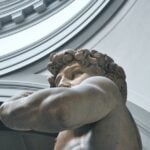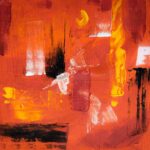Deep within the canvas lies the artificer’s hand, weaving a tapestry of imagination and skill. In the realm of art, errors do not stain the beauty of the creation but rather stand as signposts of the artist’s technique and aptitude. As we embark on a journey of interpretation and analysis, let us unravel the true impact of artificers on the final outcome. In this article, titled “The Impact of Artificers: Dissecting Errors in Art,” we delve into the complexities of creative expression, uncovering the nuances that differentiate errors from intrinsic qualities of the art form itself. Join us as we explore the craftsmanship behind art and shed light on the role of the artificer in the pursuit of perfection.

Key Takeaways:
- Errors in art are not a reflection of the art itself, but rather the flaws of the artist who created it.
- Imperfections in art should be understood as a natural part of the creative process.
- Isaac Newton’s quote emphasizes that mistakes and inaccuracies in art are due to the limitations and fallibility of the artist, not the inherent nature of the art form.
- Newton distinguishes between geometrical accuracy and mechanical accuracy, suggesting that mechanical accuracy is more prone to errors.
- Newton’s quote serves as a reminder to consider errors in art in the context of the artist’s humanity and imperfections.
Errors are not in the art but in the artificers
As renowned mathematician and philosopher Isaac Newton once stated, “Errors are not in the art, but in the artificers.” This quote encapsulates an intriguing perspective on the imperfections found within works of art. It suggests that any flaws or mistakes present in a piece of art should not be attributed to the art form itself, but rather to the limitations and fallibility of the artists who created it.
Understanding Newton’s quote
To fully grasp the essence of Newton’s quote, it is important to dissect its meaning. Newton draws a distinction between mechanics and geometry, stating that what is perfectly accurate is referred to as geometrical, while what is less accurate is deemed mechanical. In other words, there is a differentiation between the precision of a mathematical or geometric concept and the potential for errors within the realm of practical implementation.
When applied to the context of art, Newton’s quote suggests that while art itself possesses an inherent beauty and potential for perfection, the final product may not always reflect these qualities. The imperfections within a work of art are not an indictment of the art form itself, but rather a reflection of the limitations of the artists who created it.
Embracing the imperfections
Art, at its core, is a testament to the human experience. Artists pour their emotions, ideas, and skills into their creations, but they are not infallible. Just like any other profession or craft, artists are prone to errors and shortcomings. Their work is not exempt from imperfections, and it is in these imperfections that the true essence of humanity is often revealed.
Artists, much like everyone else, grapple with limitations, whether they are technical, conceptual, or personal. The inevitable mistakes and errors that emerge in the creative process are a testament to the human touch, the vulnerable and authentic nature of artistic expression.
The beauty of art as a reflection of humanity
Rather than dismissing errors in art as inherently negative, Newton’s quote prompts us to appreciate them as integral components of the artistic process. The flaws and mistakes become part of the narrative, embracing the uniqueness and individuality of each artwork. These imperfections give a glimpse into the artist’s journey, their struggle, and ultimately, their triumphs.
Acknowledging the role of artificers
Artificers, the individuals responsible for crafting works of art, play a crucial role in determining the final outcome. Their techniques, skills, and abilities shape the artwork, either enhancing its beauty or amplifying its errors. Newton’s quote reminds us that the onus lies not on the art itself, but rather on the artist as the creator and executor of their vision.
Conclusion
Isaac Newton’s quote, “Errors are not in the art but in the artificers,” encourages us to approach art with a nuanced perspective. It urges us to view mistakes and imperfections not as inherent flaws within the art form, but rather as reflections of the artists themselves. By embracing these errors, we gain a deeper understanding of the artistic journey and the humanity behind each masterpiece. Art, in all its forms, serves as a testament to the human experience, encapsulating both the triumphs and the flaws of its creators.
Here are some active internal links for you:
- Charles Darwin grave – Explore the final resting place of the renowned scientist and naturalist, Charles Darwin, and learn more about his remarkable contributions to evolutionary theory.
- Punta dance in Honduras – Experience the vibrant rhythms and infectious energy of Punta, the traditional dance of Honduras. Click here to discover the cultural significance and captivating moves of this lively dance form.
- Guatemala national anthem song – Immerse yourself in the stirring melodies and patriotic spirit of Guatemala’s national anthem. Listen to the enchanting song that symbolizes the country’s rich heritage and unity.
- Interesting facts in Spanish – ¿Te gustaría aprender datos interesantes en español? Discover fascinating facts about a wide range of topics, from history and culture to science and nature. Haz clic aquí to expand your knowledge in Spanish!
- Makkah Royal Clock Tower – Marvel at the iconic Makkah Royal Clock Tower, a towering structure that graces the skyline of Mecca. Click here to explore the architectural magnificence and learn about its significance in Islam.
Exploring the Craftsmanship Behind Art
Have you ever wondered where errors in art come from? Why do some artworks have imperfections that seem out of place? Renowned English mathematician, physicist, and philosopher Isaac Newton once said, “Errors are not in the art but in the artificers.” This quote sheds light on the idea that mistakes in art are not inherent to the art form itself, but rather a result of the fallibility of the people who create it.
Newton’s quote carries a powerful message that artists, craftsmen, and creators are responsible for any errors or imperfections that may arise in their work. It emphasizes the need to recognize and embrace fallibility as an integral part of the creative process.
When exploring the craftsmanship behind art, it is important to acknowledge the potential for errors and imperfections. These can arise from various factors such as incorrect lever-arm definitions, time delays, or misalignments in motion sensors. By recognizing and addressing these common errors, artists can strive for improved artistic outcomes.
Additionally, Newton’s quote reminds us that mistakes are not necessarily detrimental to art. In fact, they can be seen as opportunities for growth and learning. Embracing fallibility pushes artists to evolve and refine their work, ultimately allowing them to create innovative and meaningful art.
The connection between art and artifice is also highlighted by Newton’s quote. While art refers to the creative expression and craftsmanship of an artist, artifice refers to the artificial or contrived aspect of a work. These two concepts are intertwined, as artists often rely on artifice to create personas in their roles, demonstrating the close relationship between art and artifice.
To gain a deeper understanding and appreciation of artwork, it is essential to consider the context in which it is created. Historical events, social conditions, biographical facts about the artist, and their intentions all play a role in shaping a work of art. By examining these factors, viewers can unravel the intricacies of the craftsmanship behind art and develop a more profound connection with the artwork.
In conclusion, errors in art should not be attributed to the art form itself but rather to the limitations and fallibility of the artists who create it. By exploring the craftsmanship behind art, we can appreciate the true essence of artistic expression and understand that errors are opportunities for growth and evolution. So let’s embrace the imperfections and delve deeper into the rich world of art, where creativity and fallibility intertwine.
Key Takeaways:
- Newton’s quote emphasizes that errors in art are the result of the fallibility of the artists, not inherent flaws in the art form itself.
- Exploring the craftsmanship behind art involves acknowledging and addressing errors and imperfections.
- Mistakes in art can be seen as opportunities for growth and learning, pushing artists to evolve and refine their work.
- The connection between art and artifice highlights the artificial or contrived aspects of a work and the role of the artist in creating personas.
- Considering the context in which art is created allows viewers to gain a deeper understanding and appreciation of the artwork.
Citations:
1. Socratic Method
2. BrainyQuote
Questioning the concept of “error” in art
Key Takeaways:
- Errors in art are not inherent to the art form itself, but rather a result of the limitations and fallibility of the artists who create it.
- Isaac Newton’s quote “Errors are not in the art but in the artificers” highlights that imperfections in art stem from the mistakes made by the artists, not from the nature of the art itself.
- Artistic expression often involves miscalculations and errors, which can lead to masterpieces and innovative creations.
- Glitch art, a form of visual art that embraces errors and disruptions, challenges our relationship to technology and control.
- Misjudgments in the display or exhibition of art can spark controversy and debate.
- The artistic use of error has been analyzed in various art projects and essays, shedding light on its long history and significance in the artistic realm.
- Error management in art refers to how artists handle and respond to errors during artistic performances.
Art, in its various forms, has always been subject to scrutiny and analysis. As a seasoned art critic, I have come to question the concept of “error” within the domain of art. Isaac Newton’s famous quote, “Errors are not in the art but in the artificers,” has particularly caught my attention. It suggests that the mistakes present in a work of art do not lie within the art itself but rather in the imperfections of the artists who bring it to life.
Artists, much like artisans, do not work with perfect accuracy. The realm of artistry differentiates itself from the precision of mechanics or geometry. It is within this realm that errors can arise. These errors, however, do not diminish the inherent beauty and potential for perfection within art. Instead, they reflect the fallibility and limitations of the artists themselves.
One might argue that the mistakes made while creating art are integral components of the artistic process. Art cannot exist without them. Throughout history, notable masterpieces and revolutionary inventions have emerged from unforeseen miscalculations and errors. Glitch art, for instance, is a modern form of visual expression that deliberately incorporates errors and disruptions to challenge our relationship with technology and control.
Errors in art can extend beyond the creative process and into the display and exhibition of artwork. A misjudgment in the presentation of art can spark controversy and ignite discussions about the intentions and implications behind the piece. One artist’s mistake can lead to a deeper examination of social, cultural, and ethical matters.
The concept of error in art has been analyzed and explored in various art projects and essays. Artists have intentionally utilized errors to provoke thought and engage audiences in a critical dialogue. These examinations of error in art shed light on its long history and the significant role it plays within the artistic realm.
Error management also holds relevance in the context of artistic performances. How artists handle and respond to errors during their artistic endeavors can shape the overall experience for both themselves and the audience. Acknowledging and addressing errors and imperfections is therefore of utmost importance in the craftsmanship of art.
In conclusion, when questioning the concept of “error” in art, it becomes evident that errors are not intrinsic to the art form itself but rather a reflection of the artificers. Artists, like all humans, are fallible and prone to mistakes. Embracing and appreciating these mistakes allows for a deeper understanding of the artistic journey and the humanity behind each masterpiece. Errors in art contribute to the richness and authenticity of artistic expression, captivating audiences and unraveling new layers of interpretation.
Sources:
- Quotescosmos – Isaac Newton quote source
- AZQuotes – Isaac Newton quote source
Understanding the impact of artificers on the final product
Introduction:
Isaac Newton once said, “Errors are not in the art but in the artificers.” This quote raises an interesting question about the role of artists in the creation of art. Do errors and imperfections in art stem from the art form itself, or are they a reflection of the artist’s capabilities and techniques? In this article, we will explore this concept and delve into the impact of artificers on the final product.
The Essence of Art:
Art, in its purest form, is flawless and perfect. It embodies a sense of beauty and excellence that is intrinsic to its nature. The art itself is faultless, untouched by errors. However, it is the artificers, the artists, who introduce their own flaws and limitations into their creations. They bring their unique perspectives, styles, and craftsmanship, which ultimately shape the final artwork.
Fallibility and Growth:
Newton’s quote suggests that errors and imperfections are an inevitable part of the artistic process. It acknowledges the fallibility of human beings and highlights the importance of learning and growth. Artists are not exempt from making mistakes; in fact, these errors provide valuable opportunities for improvement. Through continuous practice and self-reflection, artists can refine their craft and evolve as creators.
The Rational and Practical Perspectives:
To better understand Newton’s quote, we can draw a parallel with the ancient perception of mechanics. The ancients had a rational perspective that focused on accurate and demonstrative processes, while the practical perspective emphasized their application. Similarly, the idea that errors are not in the art but in the artificers aligns with this duality. It emphasizes that errors are not inherent in the rational framework of art but rather manifest in its practical execution.
The Role of Artists:
Artists, as the artificers, play a pivotal role in shaping the final outcome of a work of art. They have the power to influence the quality, aesthetics, and impact of their creations. With this power comes great responsibility. Artists must be self-aware and dedicated to their craft, recognizing that errors and imperfections are part of the creative process. By acknowledging and addressing these errors, artists can strive for mastery and contribute to the ever-evolving world of art.
Key Takeaways:
– The quote “Errors are not in the art but in the artificers” highlights that imperfections in art come from the mistakes made by artists.
– Art possesses inherent perfection, but errors and imperfections are introduced by the artificers.
– Fallibility is an integral part of the artistic process and provides opportunities for growth and improvement.
– The duality of the rational and practical perspectives can be seen in the distinction between errors in art and the art form itself.
– Artists hold significant power and responsibility in shaping the final product of their creations.
Sources:
– Socratic Method
– Plato’s Mirror

FAQ
Q1: What does the quote “Errors are not in the art but in the artificers” by Isaac Newton mean?
A1: This quote suggests that any mistakes or imperfections in a work of art are not inherent flaws of the art itself, but rather a reflection of the fallibility and limitations of the artists who created it. It emphasizes the distinction between the perfection of art and the individual errors introduced by the artificers.
Q2: How does Newton’s quote relate to the artistic process?
A2: Newton’s quote highlights the idea that errors and imperfections are a natural part of the artistic process. It acknowledges that artists, like all individuals, are fallible and susceptible to making mistakes. These errors, rather than being detrimental to art, can be seen as opportunities for growth and learning for the artists.
Q3: What is the difference between mechanics and art as mentioned in the quote?
A3: In the quote, Newton distinguishes between mechanics and art, stating that what is perfectly accurate is called geometrical, while what is less accurate is referred to as mechanical. This differentiation underscores the idea that mechanics may be prone to errors, whereas art itself is not inherently flawed but can be influenced by the artificers’ limitations.
Q4: How does the quote emphasize the role of artists?
A4: Newton’s quote places the responsibility on the artificers or artists, attributing errors and imperfections in art to their fallibility. It underscores that artists have a crucial role in shaping and influencing the quality of their work. This highlights the importance of self-awareness and dedication in the artistic journey.
Q5: What is the significance of embracing fallibility in art?
A5: Embracing fallibility in art means acknowledging and accepting that errors and imperfections are an integral part of the creative process. It encourages artists to learn from their mistakes and strive for continuous growth. By embracing fallibility, artists can push the boundaries of their craft and create innovative and meaningful art.
- Sept 31 Myth: Unveiling Calendar Secrets - March 18, 2025
- How Long & Till December 18, 2025: Accurate Countdown Guide - March 18, 2025
- Discover Japanese Artists: A Complete History - March 18, 2025
















